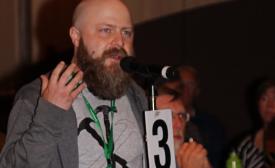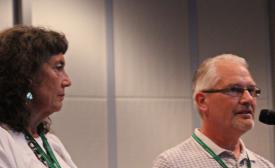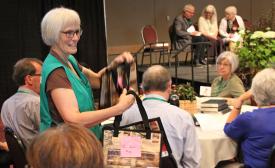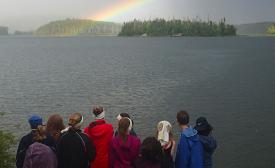Volume 20, Number 15
Taking down our harps
“By the rivers of Babylon we sat and wept when we remembered Zion. On the willows there we hung up our harps” (Psalm 137: 1-2).
Hope through lament and loss

Randell Neudorf, pastor of the Commons church in Hamilton, Ont., speaks in favour of the resolution to repudiate the Doctrine of Discovery. Neudorf spoke of wanting his son, who has an Ojibway background, to grow up in a land that sees him and his people as full members of the human family. The Doctrine of Discovery is a historical belief that lands without Christian inhabitants were empty and open to the predation of Christian princes. The Doctrine continues to influence the law about Indigenous Peoples in Canada (Photo by Dave Rogalsky)

Mennonite Church B.C. moderator Lee Dyck, left, and executive minister Gary Janzen suggest changes to the Being a Faithful Church recommendation on July 9 at MC Canada’s Assembly 2016, before discussion and the vote to approve the amended recommendation. (Photo by Dave Rogalsky)

Harry Lafond of the Muskeg Lake Cree Nation, left, chats with Ben Pauls during a tour of the Saskatchewan first nation on July 9, during Assembly 2016. (Photo by Dave Rogalsky)
“A season of change,” lament, fear, anxiety, confession, uncertainty, safe space, brave space . . . hope.
Ready for God’s response?
With poetic grace and an invitational tone, Cynthia Wallace of Warman (Sask.) Mennonite Church challenged Assembly 2016 participants at the July 6 worship service to dream boldly and then asked if they were ready for God’s response.
Covenant and law: A matter of relationship
Over two days at Mennonite Church Canada’s Assembly 2016, “God~Faith~People,” keynote speaker Safwat Marzouk addressed the topic of covenant that was central to the theme text, Jeremiah 31:33.
During the July 7 worship service, he explained that covenant is an agreement of mutual obligation, in which each party has the ability and responsibility to uphold his or her side.
Making a case for community
“Too often Mennonites have focussed on disunity.”
With these words, Gareth Brandt began his seminar, “Running towards community,” and he then showed how Mennonite/Anabaptist history is pockmarked with splits and schisms. But Brandt said that he sees these splits as inevitable. “If everybody has a voice, then you’re going to have these splits,” he said of Mennonite polity.
‘Young adults don’t need the church’
The seminar title started in response to the young adult “problem.”
“[‘Young adults don’t need the church’] is not meant to be a defiance statement, but a statement of fact,” said presenter Chris Brnjas, a co-founder of Pastors in Exile (PiE) in southwestern Ontario. “The church is no longer a central force in the lives of young adults.”
The future lies in the past
Ken Quiring is convinced that the future of biblical literacy lies in video. This may be one reason why he and others like him have joined a growing movement known as “biblical storytelling
‘We are all responsible for what happens next’
Although a concrete picture of what Mennonite Church Canada might look like in two years isn’t yet determined, 318 delegates voted to approve in principle the direction proposed by the Future Directions Task Force to develop a more integrated nationwide church body; 21 voted against, and 4 ballots were spoiled.
A vision for the MHC Archives and Gallery
Did you know that if all of the textual records and photographs in Winnipeg’s Mennonite Heritage Centre (MHC) Archives and Gallery were stacked on top of each other, they would be taller than the CN Tower?
That was one of the facts Korey Dyck shared during a seminar entitled “History matters: A new vision for the Mennonite Heritage Centre” that he led.
Delegates vote to allow space for differences
Nine years of careful study, sensitive listening, deep engagement by many, but not all, congregations—and innumerable meetings of the Being a Faithful Church (BFC) Task Force—led to a large majority vote in favour of creating space for congregations to differ from one another when it comes to same-sex relationships.
The place of a ‘confession’ in church life
In his seminar “Confessions of faith: Sources of unity or division,” Karl Koop told the story of 3,000 Mennonites who met during a five-hour meeting in Amsterdam in 1639 to bring together three Mennonite groups that had been severely divided.
Looking to the future of Canadian Mennonite
Canadian Mennonite has been around in some form or other for 62 years, and as editor Dick Benner pointed out, the Mennonite church in Canada has witnessed many changes during that time.
How the church can move creation care forward
Following on the heels of the delegate sessions for Mennonite Church Canada, about 40 interested leaders got together at Wanuskawin Heritage Park in Saskatoon to think about how to move forward the agenda of creation care, particularly the issue of climate change, in Mennonite congregations across Canada
‘We’re not your stereotypical teenagers’
When an intense rainstorm started just as Mennonite Church Canada Youth Assembly 2016 participants set up their tents during the first afternoon of their canoe trip, organizer Krista Loewen was apprehensive.
Laments and hopes for MC Canada
When Laura Carr-Pries got together with fellow students at Canadian Mennonite University (CMU) in Winnipeg last year to discuss the challenges facing Mennonite Church Canada, she wasn’t sure how things would go.
Readers write: July 25, 2016 issue
Use land for food production, not burying the dead
Delegates have spoken
In a much-anticipated assembly, delegates have clearly spoken on behalf of Mennonite Church Canada. After an eight-year Being a Faithful Church (BFC) process, delegates approved the BFC7 recommendation with an 85 percent majority. This is clear affirmation for seeking a way forward together in responding to committed same-sex relationships.
Healthy diversity
“What does a healthy congregation look like?” I asked a pastor friend recently. He responded by telling a story of how he had led his congregation through a contentious issue. In the process, people spoke openly of their views, listened carefully, and, in the end, came to a satisfactory understanding about how to live with their differences.
Joy proposition: Give till it feels good
In my childhood home, we had a unique red velveteen bag. When you pressed on the bag in the right place, you heard the sound of someone laughing, really guffawing. The recording went on for at least a full minute and you could almost hear the person wiping the tears from his eyes.
The pursuit of truth (Pt. 7)
American architect Frank Lloyd Wright said, “The truth is more important than the facts.”
I agree, although I’m not sure that I could explain why. What is the difference between truth and fact?
Old Order Mennonite farmer
An Old Order Mennonite farmer in Waterloo Region, Ont., works the fields by horsepower in 1950, much as his 19th-century counterparts would have done.


























